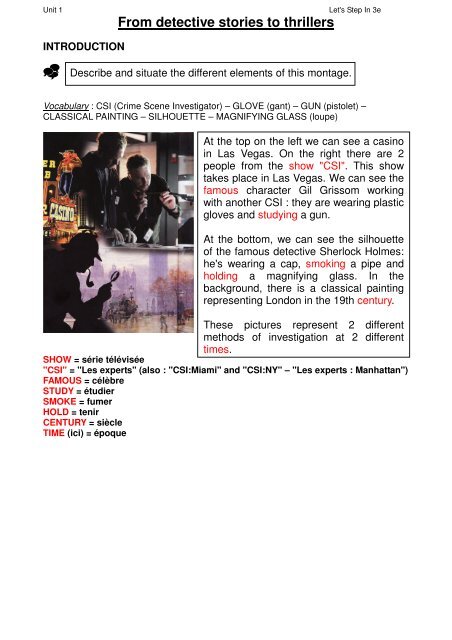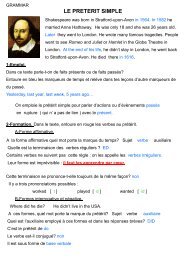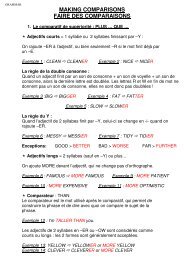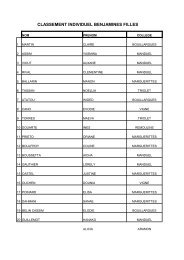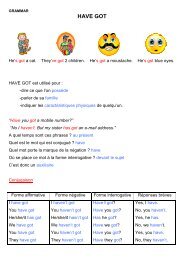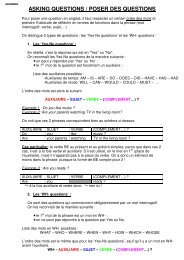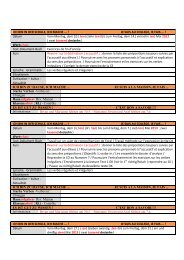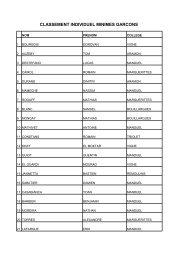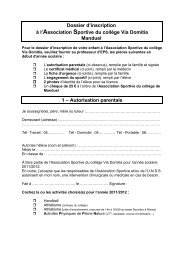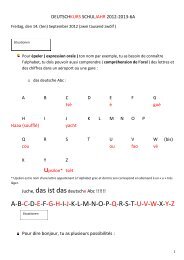Unit 1 : From detective stories to thrillers
Unit 1 : From detective stories to thrillers
Unit 1 : From detective stories to thrillers
You also want an ePaper? Increase the reach of your titles
YUMPU automatically turns print PDFs into web optimized ePapers that Google loves.
<strong>Unit</strong> 1 Let's Step In 3e<br />
<strong>From</strong> <strong>detective</strong> <strong>s<strong>to</strong>ries</strong> <strong>to</strong> <strong>thrillers</strong><br />
INTRODUCTION<br />
Describe and situate the different elements of this montage.<br />
Vocabulary : CSI (Crime Scene Investiga<strong>to</strong>r) – GLOVE (gant) – GUN (pis<strong>to</strong>let) –<br />
CLASSICAL PAINTING – SILHOUETTE – MAGNIFYING GLASS (loupe)<br />
At the <strong>to</strong>p on the left we can see a casino<br />
in Las Vegas. On the right there are 2<br />
people from the show "CSI". This show<br />
takes place in Las Vegas. We can see the<br />
famous character Gil Grissom working<br />
with another CSI : they are wearing plastic<br />
gloves and studying a gun.<br />
At the bot<strong>to</strong>m, we can see the silhouette<br />
of the famous <strong>detective</strong> Sherlock Holmes:<br />
he's wearing a cap, smoking a pipe and<br />
holding a magnifying glass. In the<br />
background, there is a classical painting<br />
representing London in the 19th century.<br />
These pictures represent 2 different<br />
methods of investigation at 2 different<br />
times.<br />
SHOW = série télévisée<br />
"CSI'' = "Les experts" (also : "CSI:Miami" and "CSI:NY" – "Les experts : Manhattan")<br />
FAMOUS = célèbre<br />
STUDY = étudier<br />
SMOKE = fumer<br />
HOLD = tenir<br />
CENTURY = siècle<br />
TIME (ici) = époque
STARTER : Solve a murder mystery !<br />
The cook The daughter The gardener The maid The wife<br />
ALIBIS [æləbaɪz] ɪz]<br />
The victim = the rich father / husband<br />
Date of the crime = Sunday morning<br />
CHARACTERS COOK DAUGHTER GARDENER MAID WIFE<br />
ACTIONS cooking getting the<br />
mail<br />
planting<br />
seeds<br />
cleaning the<br />
windows<br />
reading a<br />
book<br />
The DAUGHTER is lying because THERE IS NO MAIL ON SUNDAY MORNINGS.
<strong>Unit</strong> 1 Let's Step In 3e<br />
STEP 1<br />
: Je rédige une biographie<br />
A. What do you know about Agatha Christie ?<br />
<br />
Look at the following documents and make sentences <strong>to</strong> say<br />
what you know or what you can guess about Agatha Christie.<br />
Use the word bank.<br />
WORD BANK : TYPEWRITER (machine à écrire) NICKNAME (surnom)<br />
NOVEL (roman) FAMOUS CHARACTERS (personnages célèbres) ADAPTED<br />
HEADLINE (manchette de journal) MAYBE = PERHAPS I SUPPOSE... I GUESS...<br />
Agatha Christie was a writer : her nickname was the Queen of Crime. She<br />
created 2 famous characters : Hercule Poirot is a Belgian <strong>detective</strong> and Miss<br />
Marple is an old lady.<br />
2 of her novels were adapted for the cinema : Murder On The Orient Express<br />
in 1974 and Death On The Nile in 1978. Agatha Christie died in 1976.<br />
B. Facts about Agatha Christie ?<br />
Summary from the information collected in the workbook p. 14<br />
Agatha Christie was born on 15th September 1890 in Torquay. She studied at home<br />
with her mother, then she studied piano and singing in Paris.<br />
In 1914 she married Archibald Christie. She had one daughter in 1919. In 1928 she<br />
divorced and she married again in 1930. Her husband was an archaelogist.<br />
She wrote her first <strong>detective</strong> novel in 1920 : its title was ''The Mysterious Affair at<br />
Styles''. In all she wrote more than 60 <strong>detective</strong> novels and more than 12 plays.<br />
Agatha Christie died in 1976 of natural causes.
A. Are you a good observer ?<br />
STEP 1<br />
: Je décris une scène dont j'ai été le témoin<br />
Comparer ce qui se passe maintenant avec ce qui se passait à un moment donné<br />
Utiliser le Présent Be-ING et le Prétérit Be-ING.<br />
In the picture , the man was holding a hat<br />
...WHEREAS...<br />
in the workbook, he is smoking a pipe.<br />
In the picture, the dog was sitting whereas in the workbook it is standing.<br />
In the picture, the children were playing marbles whereas in the workbook they<br />
are playing with a ball.<br />
In the picture, the man on the bike had a moustache whereas in the workbook<br />
he doesn't have one.<br />
Le Présent et le Prétérit Be-ING ne sont utilisés que pour évoquer des actions ou des<br />
activités. Dans la dernière phrase, ''avoir une moustache" n'est pas une activité, mais plutôt une<br />
caractéristique physique. Dans ce cas ce sont les temps simples qui s'imposent : Présent et<br />
Prétérit Simples.<br />
WHEREAS = alors que, tandis que (mot de liaison)
B. What kind of <strong>detective</strong> is Hercule Poirot ?<br />
Read an extract from The Mysterious Affair at Styles, by Agatha Christie.<br />
1. Be logical and find the meaning of these expressions:<br />
-HATLESS = sans son chapeau (HAT + suffixe privatif –LESS)<br />
-GESTICULATING < GESTICULATE = gesticuler (verbe de racine latine)<br />
-GESTURE OF DESPAIR = geste de désespoir<br />
-CARD HOUSES = châteaux de cartes<br />
2. Find 4 synonyms for ''RUN'' in the text:<br />
RUSH (l. 2) DASH (l. 4) HURRY (l. 5) TEAR (l. 5)<br />
3. Who says what ? Match the sentences with the right character:<br />
"And, before I could answer...in<strong>to</strong> the street." Hercule Poirot<br />
"For the love of Heaven, direct me <strong>to</strong> a garage." Captain Hasting<br />
"There he goes, round the corner!" Mary Cavendish
STEP 2<br />
: Je parle des habitudes passées<br />
1 GET READY !<br />
How did investiga<strong>to</strong>rs solve crimes in 1900 ?<br />
BULLETS FINGERPRINTS BLOOD SAMPLES<br />
In 1835 Goddard MADE the first bullet comparison.<br />
In 1880 Faulds IDENTIFIED a culprit with his FINGERPRINTS for the first time.<br />
In 1910 Locard CREATED the first Crime Lab in Lyon.<br />
In 1937 Specht first DETECTED blood traces by SPRAYING Luminol.<br />
In 1986 Jeffreys first EXTRACTED DNA from blood SAMPLES.<br />
Poser une question sur les techniques d'investigation en 1900;<br />
Répondre par une réponse courte et donner une explication en précisant la<br />
date à laquelle cette technique a été créée.<br />
1. Did investiga<strong>to</strong>rs identify a culprit with his fingerprints in 1900 ?<br />
2. Yes, they did because Faulds identified a culprit with his fingerprints for<br />
the first time in 1880.<br />
<br />
1. Did investiga<strong>to</strong>rs create crime labs in 1900 ?<br />
2. No, they didn't because Locard created the first Crime Lab in 1910.<br />
<br />
1. Did investiga<strong>to</strong>rs extract DNA in 1900 ?<br />
2. No, they didn't because Jeffreys first extracted DNA in 1986.
3 façons de parler de la première fois que qqch a lieu :<br />
- Expression : FOR THE FIRST TIME = pour la première fois (en fin de phrase)<br />
- Adjectif : THE FIRST ... = le premier ... / la première ... (avant un nom)<br />
- Adverbe : FIRST = en premier (avant un verbe)<br />
2 STEP FORWARD !<br />
A I used <strong>to</strong> be a forensic scientist.<br />
Pour parler d'une habitude du passé, révolue aujourd'hui, on emploie l'expression<br />
USED TO + base verbale. Cette expression fonctionne comme un verbe au prétérit :<br />
Forme négative : SUBJECT + DIDN'T USE TO + base verbale<br />
Forme interrogative : DID + SUBJECT + USE TO + base verbale<br />
Pour parler de ce qu'on ne fait plus, on emploie :<br />
Forme négative + ANY MORE en fin de phrase<br />
ou<br />
Sujet + NO LONGER + verbe (forme affirmative)<br />
B Write an article in a newspaper.<br />
Réunir des infos pour écrire un résumé<br />
WB : Ex. B p. 23<br />
Donner son année et son lieu de naissance;<br />
Parler de ses hobbies à l'école;<br />
Dire qu'il ne vit plus à Bris<strong>to</strong>l, et qu'il a déménagé* à Londres dans les années 60;<br />
Dire quel était son métier, expliquer en quoi consistait ce métier;<br />
Indiquer en quelle année il a changé de métier*;<br />
Préciser ce qu'il fait à présent;<br />
Dire qu'il ne s'occupe* plus de scènes de crimes aujourd'hui.<br />
VOCAB.: MOVE = déménager, CHANGE JOBS = changer de métier, DEAL WITH = s'occuper de.<br />
Gary Jenkins was born in 1955 in Bris<strong>to</strong>l. At school, he used <strong>to</strong> play cards<br />
and <strong>detective</strong>s with friends. He no longer lives in Bris<strong>to</strong>l : he moved <strong>to</strong> London<br />
in the 60s. He used <strong>to</strong> be a forensic scientist : he used <strong>to</strong> collect samples and<br />
detect blood traces. He changed jobs in 1989. Now he is a lecturer in forensic<br />
science at the university. Today, he doesn't deal with crime scenes any more.<br />
USED TO : exprime une habitude du passé<br />
NO LONGER / NOT... ANY MORE : ne ... plus<br />
base verbale et marques du temps
C An unusual way <strong>to</strong> investigate.<br />
Read an article about Frances Glessner Lee and answer the questions.<br />
NUTSHELL = NUT + SHELL = + = "coquille de noix" in French.<br />
2. Quote her mot<strong>to</strong> and translate it :<br />
"Convict the guilty, clear the innocent and find the truth in a nutshell !''<br />
Confondre le coupable, disculper l'innocent et trouver la vérité dans une coquille de noix.<br />
What's a mot<strong>to</strong> in French ? DEVISE<br />
3. What's the nature of her work ?<br />
It consists of 19 miniature crime scenes. She called them "the Nutshell Studies of<br />
Unexplained Death", which is in French : les Etudes de Coquilles de Noix de la Mort<br />
Inexpliquée.<br />
4. Find a synonym for ''CAUSE OF DEATH'' in the text (§ 2): MANNER OF DEATH<br />
5. Quote a sentence from the text where the verb USE means ''UTILISER'':<br />
"... she used her fortune <strong>to</strong> help establish Harvard's Department of Legal Medicine."<br />
6. Quote another sentence where the verb USE expresses a habit from the past:<br />
"...students used <strong>to</strong> train <strong>to</strong> examine all the clues..."<br />
"They used <strong>to</strong> look at each crime scenario..."<br />
WB 1 p. 23 : Now answer questions a <strong>to</strong> h in your workbook.
Make it yours !<br />
WB p. 24<br />
The following expressions are taken from the sequence : number them in the right<br />
order.<br />
4-YEAR DEGREE 7-YEAR SERVICE CRIME LABS EXPERT WITNESSES<br />
<br />
HIGHLY TRAINED IDENT OFFICERS IDENT SECTION JOB OPTIONS<br />
1<br />
Now sum up what you have unders<strong>to</strong>od :<br />
SUBMIT REPORTS<br />
<br />
A CSI is a police officer working at crime scenes ; he collects evidence and takes<br />
pho<strong>to</strong>s.<br />
A forensic scientist is a civilian : he analyses evidence in a labora<strong>to</strong>ry and often<br />
testifies in court.<br />
None of them interview suspects.<br />
! NONE OF THEM est suivi du pluriel, car on considère un groupe de<br />
personnes.
<strong>Unit</strong> 1 Let's Step In 3e<br />
STEP 3<br />
: Je relève des informations et prolonge un récit<br />
1 GET READY !<br />
Imagine a s<strong>to</strong>ry from a sound sequence.<br />
The wind was blowing and the rain<br />
was falling. A dog was barking.<br />
Suddenly a man entered a house<br />
when the door creaked.<br />
BARK (aboyer) – BLOW (souffler)<br />
ENTER – CREAK (grincer)<br />
! context, situation ≠ event, action<br />
Then the man was going up <strong>to</strong> the<br />
first floor while the bells were ringing.<br />
He opened the door <strong>to</strong> the library and<br />
he found a safe.<br />
GO UP (monter) – RING (sonner)<br />
OPEN – LIBRARY<br />
FIND – SAFE (coffre-fort)<br />
When the man forced the safe, he<br />
s<strong>to</strong>le the money, but a woman saw<br />
him. She shouted but he ran away<br />
and escaped.<br />
FORCE (fracturer) – STEAL<br />
SHOUT – RUN AWAY – ESCAPE


